Epipremnum aureum (family Araceae), commonly referred to as pothos, devil’s ivy or pothos vine, contains some of the most popular and durable interior tropical ornamental foliage plants. The genus Epipremnum and its 10 known species are tree-climbing vines native to the Solomon Islands. In tropical settings, pothos can grow to be large in size, climbing trees 50 feet tall and producing lobed leaves up to 3 feet in length.
Pothos brings a touch of the tropics with its large heart-shaped leaves and long vining stems. The variegated foliage remains green year-round but most new growth happens in spring and summer. Pothos and its attendant varieties are used for interiorscape purposes such as pedestal plants, totems, hanging baskets, groundcovers, dish gardens, and small desk plants.
The distinguishing feature between the types of pothos is their leaf variegation. Some plants have dark leaves, and other pothos have bright lemon and lime-colored leaves, and other have green and white leaves. Common commercial cultivars include the standard golden pothos (green leaves with varying degrees of irregular yellowish variegation), marble queen (white variegation), jade (uniform dark green leaves with no variegation), and neon, which displays uniform chartreuse-colored leaves.
Given that Pothos produces long vines. You can stake the vines or train them up a nearby support if you grow pothos in a standard pot. Hanging baskets provide another option that doesn’t require staking. Instead of climbing, the vines will trail over the edge of the basket and hang down. Plastic hanging baskets with an attached drainage tray work best indoors because they don’t dry quickly and the tray prevents water drips. Coir- or peat-lined baskets are attractive, but they tend to dry out quickly and draining water can make a mess indoors.
While pothos are reported to be able to improve indoor air quality, they also are toxic to both people and pets, so keep this in mind concerning children, dogs and cats. Overall, pothos plants are well-loved selections favored by houseplant enthusiasts.
And, unlike other houseplants, pothos plants are incredibly forgiving and can survive in a variety of conditions. If you are new to plants or are just looking for an easy addition to your home, a pothos plant is a great option.
Some varieties are better for indoor growing, while others are better for outdoor growing. Some varieties can grow very large, while others stay very small. In this article, we’ll explore the different varieties of pothos and discuss what to look for when choosing which one is right for you.
Varieties Of Pothos
1. Golden Pothos
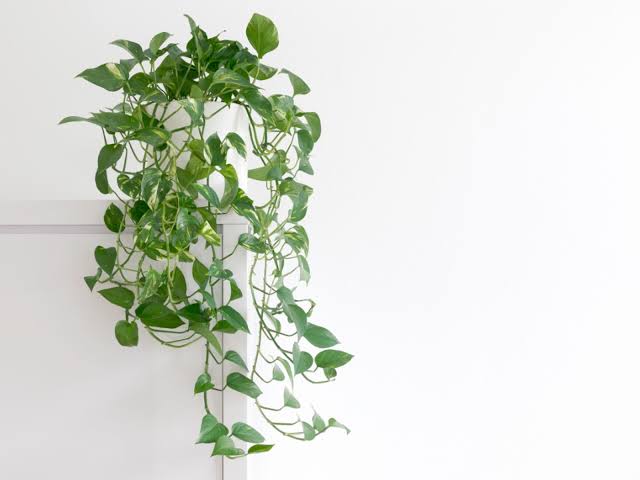
Golden pothos has large, glossy green with irregular cream and yellow streaks and blotches. It only grows 6-8 ft as a horizontal groundcover, but the trailing, climbing vines can grow as long as 40 ft. Golden Pothos also tolerates lower light levels without losing its variegation and looks best displayed as a hanging plant.
2. Marble Queen Pothos
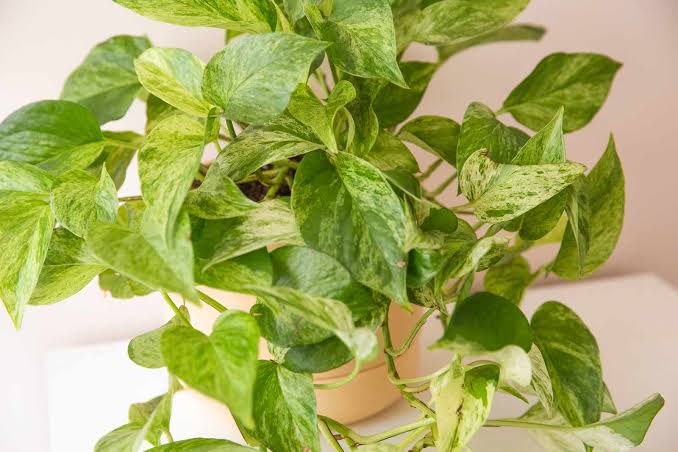
Marble Queen Pothos is known for its bright green heart shaped leaves that show a splattered bright white variegation. This species is versatile and highly tolerant of low light conditions and is an easy-to-care-for houseplant. It can grow long cascading vines and pairs well with a hanging planter or standard planter placed up on a shelf. Marble Queen Pothos is fairly tolerant to a variety of light conditions, best positioned in moderate to bright light. Its variegation will be more extreme in brighter light.
Also Read: Types of Begonia Varieties
3. Neon Pothos

Neon pothos is a wonderfully vibrant variety of Golden Pothos, with bright chartreuse yellow leaves with no variegation. Neon pothos are vigorous growers and do well in hanging baskets or anyplace where their trailing vines can fall freely. Because they tolerate low light, Neon pothos plants can grow in a bathroom or office. Neon pothos cuttings can even live for years in plain water, so this makes it easy to add a houseplant to hard-to-reach places, such as atop a grandfather clock.
4. Jessenia Pothos
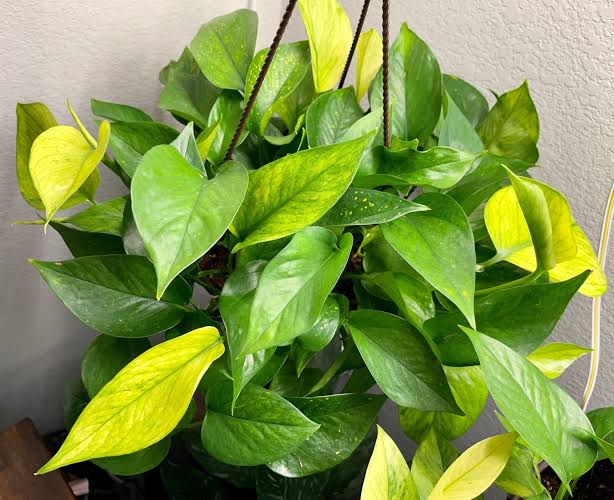
Jessenia pothos displays green, heart-shaped leaves abundantly marked with chartreuse. Like Marble Queen (to which Jessenia is quite similar), every leaf will be different. It’s usually not too hard to tell the difference between Marble Queen and Jessenia when they’re next to each other. The variegation of Marble Queen is much lighter than the limey-green variegation of Jessenia. Jessenia tends to grow more slowly than golden pothos.
Also Read: Different Types of Monstera Varieties
5. Manjula Pothos
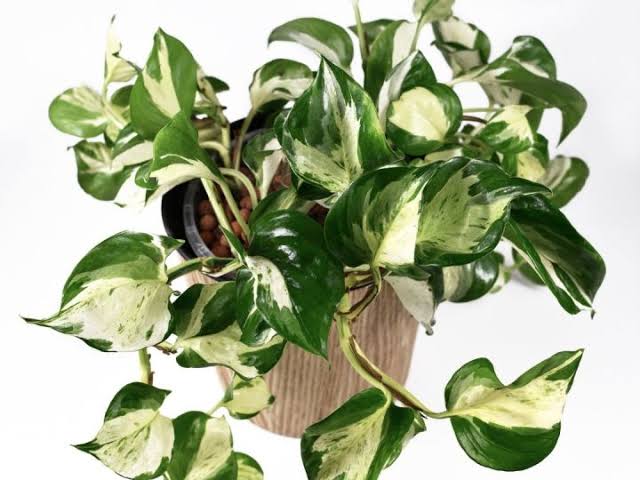
A beautiful addition to any house plant collection, the Manjula Pothos has wide, heart shaped leaves with deep green and white variegation and random marbling. They tend to have an overall horizontal, cascading growth habit, making them excellent choices for hanging baskets. You can also help these plants grow straight up by providing them with some organic support, such as a totem pole made of coconut coir. This Pothos will thrive in a brightly lit room, out of direct sunlight, and in a pot that allows free drainage away from the roots.
6. Pearls and Jade Pothos

A beautiful addition to any house plant collection, Pearl N Jade Pothos are known for their green leaves generously marked with creamy white variegation and random marbling. The variegation tends to appear more on the edges of the foliage, rather than the middle.
Unlike some other pothos varieties, the white sections of the foliage are often mottled with green and silvery gray tones. Pearls and Jade pothos tends to have smaller leaves than some of the other varieties and tends to grow more slowly.
A robust climbing vine, this plant can be grown in hanging baskets or trained to grow up totem poles. This Pothos will thrive in a brightly lit room, out of direct sunlight, and in a pot that allows free drainage away from the roots.
Also Read: Types of Tropical Flowers
7. Silver/Satin Pothos
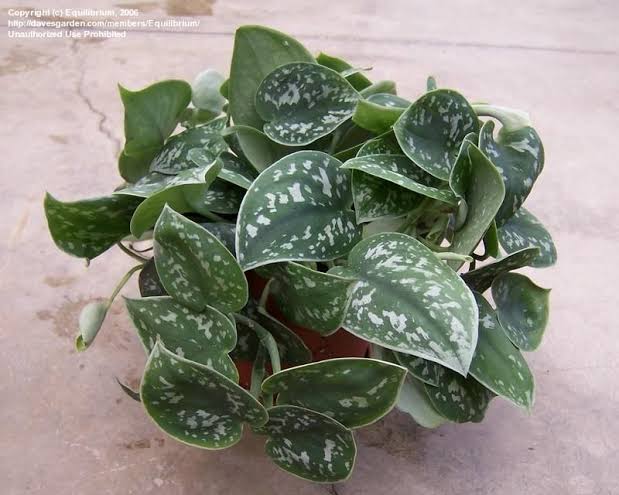
Satin pothos is a low maintenance variety. This beautiful vining plant is a great choice for beginners. They have a matte like texture and feel a bit velvety to touch, hence the common name Satin. The heart-shaped leaves have silvery grey splotches, which makes them look almost shiny and adds to the visual appeal of the plant.
Satin pothos will latch onto its surroundings—that can be a pole, a trellis, other plants, a wall, or a piece of furniture. Its compact growth habit makes Silver pothos a beautiful hanging basket plant. The Satin Pothos is used to sitting in dappled light under the trees and can handle occasional shade making it a great all rounder.
8. Cebu Blue Pothos
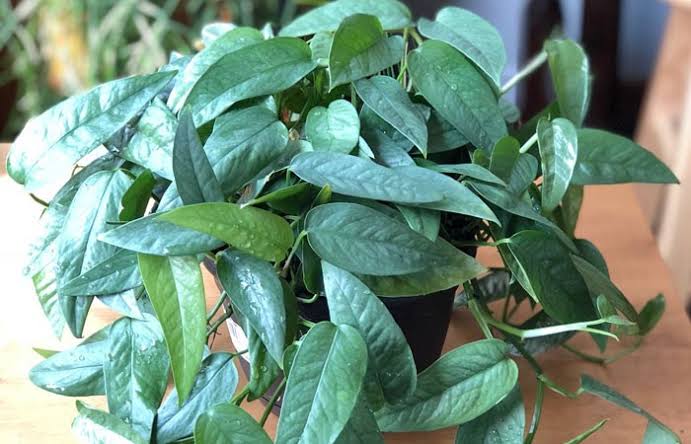
The Cebe Blue variety is one of the most unique types of pothos available today because of its silverish-blue shimmery leaves that trail and vine beautifully. The elongated heart-shaped leaves set this plant apart from other varieties that have shorter leaves. Also instead of the usual rounded shape, Cebu variety has a lanceolate shaped leaves.
The Cebu Blue is commonly found in tropical regions of Asia and Northern Australia. In nature they grow over 40 feet long with massive leaves, but indoors it’s likely to grow no more than 10 feet with leaves no longer than 4 inches.
Also Read: Different Types of Black-eyed Susan
9. Hawaiian Pothos
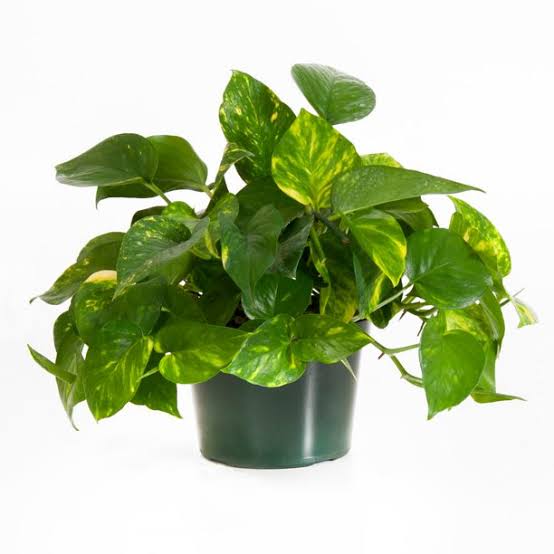
The Hawaiian pothos is a variety with huge leaves compared to other types of hanging pothos plants. The dark green foliage has speckles of yellow variegation. Actually, the appearance of Golden Pothos and Hawaiian Pothos is almost the same, except their shapes and sizes. The long vines and large leaves create an attractive vertical accent when hanging from a basket or growing up a pole. This variegated variety grows well even in low light conditions and can survive in average room humidity
10. Glacier Pothos
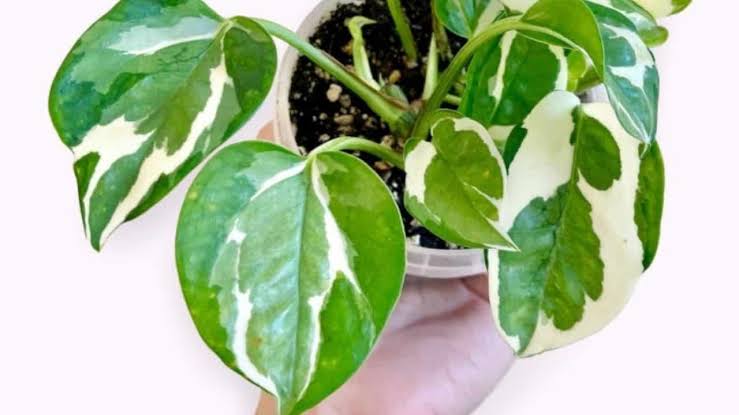
Glacier is a small pothos variety and it has a nice green and white contrast on their small leaves. Glacier Pothos is commonly confused with Pearls and Jade Pothos and Njoy Pothos although you can differentiate your Glacier because it tends to have more silvery-gray mottling/streaking than others and smaller leaves.
Due to its bushy growth habit, the glacier pothos is an excellent potted plant for tables or desks. The Glacier pothos is similar in size to the ‘Pearl and Jade’ pothos. This variegated variety grows requires more light than other pothos since in low light conditions it doesn’t grow much because the white parts of the leaves don’t capture light for photosynthesis.
11. Trebi Pothos

This type of pothos is directly related to the Silver Satin Pothos because they both come from the same genus Scindapsus. So, this isn’t a true pothos variety. However, it looks so similar and shares so many traits with the pothos plants that many people assume it is. It’s a vining houseplant that has larger leaves in a dark shade of green with a silver marbling on it. The leaves are matte over being glossy, and this gives it a very nice blue-silver appearance.
Also Read: Different Types of String Succulents
12. Snow Queen Pothos
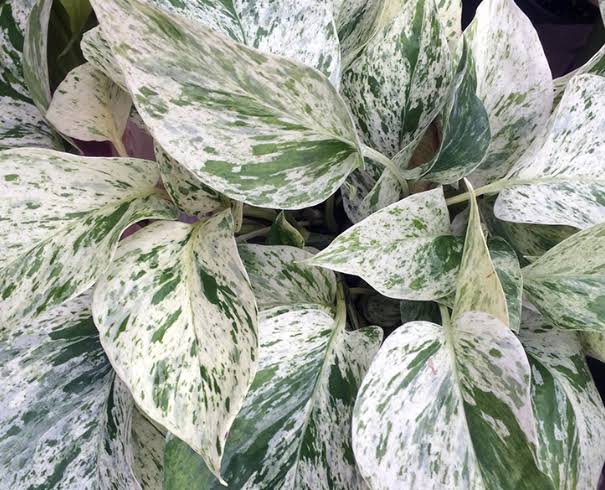
Snow Queen, as the name suggests, has stunning white markings on the leaves, very much like Marble Queen Pothos. The only difference being the snow queen has more pronounced white variegation whereas the marble pothos has a pale hue.
13. Harlequin Pothos

Harlequin is the rarest pothos to across by. Harlequin pothos looks very, very similar to manjula pothos. Harlequin pothos is a highly variegated manjula pothos with plenty of white variegation in it. The way to differentiate the two is manjula pothos tend to also have some neon, light green, lime yellow color in its variegation, while harlequin’s variegation is strictly green and white.
14. N Joy Pothos

The N Joy Pothos is typically the most recent varieties of the pothos species. It has small, broad leaves that are often ovate with green and clear white patches. Unlike in other pothos plants, white is the main color on the leaves of the N-Joy pothos.
The green on the leaf changes shades depending on the age of the plant and the amount of light, from pale to dark green. The patches on the leaves take different colors, making this plant perfect for decoration. It is also a slow-growing variety.
Where do Pothos Plants Come From?
The pothos plant is native to Southeast Asia and parts of Africa. It’s become a popular houseplant because it’s easy to care for and propagate. It’s also a great choice for beginners because it doesn’t require a lot of attention. If you’re looking for a low-maintenance plant to add a touch of green to your home, the pothos is a great option.
Pothos plants love bright, indirect sunlight and can be watered liberally (though they will tolerate periods of drought without any trouble).
Also Read: Types of Hibiscus Flowers
What are the benefits of pothos?
Pothos is a low-maintenance indoor plant that offers many benefits. Not only does it improve air quality by removing toxins like formaldehyde, benzene and xylene from the air, but it’s also a powerful filter of electromagnetic radiation. For people who spend a lot of time in front of a computer or electronic device, pothos can be a great way to counteract the negative effects of EMFs. Pothos is also known for its ability to improve productivity and creativity, making it a great addition to any office space.
How to grow pothos at home
Pothos plants are some of the easiest plants to grow indoors. There are many different varieties of pothos and they can all be propagated using leaves taken from the mother plant. To propagate a pothos, take a healthy leaf and cut it off the stem. Remove the stem of the leaf and place the cut end of the leaf in water. You will see roots start to form in a few days. Once the roots are a few inches long, plant the leaf in soil. Pothos plants do best in bright, indirect light, so make sure to place them near a window.
How do I take care of pothos?
Pothos plants are some of the easiest you can care for, making them perfect for anyone just starting out in plant care. They’re also great for people who don’t have a green thumb. Pothos plants thrive in indirect light and can even handle low light levels. They don’t need a lot of water, making them the perfect choice for anyone who tends to forget to water their plants. To water your pothos, simply spritz it with water once or twice a week. You can also water it by soaking the pot in a bowl of water for about 10 minutes.
Common mistakes people make when caring for pothos
A lot of people make common mistakes when caring for pothos. One of the most common is over-watering. Pothos don’t need a lot of water to thrive; in fact, they can tolerate dry soil quite well. Another mistake people make is giving their plants too much sunlight. Pothos do well in moderate sunlight, but too much can scorch the leaves. Finally, many people don’t realize that pothos are poisonous. So if you have pets or small children, be sure to keep your plants out of reach. With a little bit of care, pothos can transform your home into a beautiful, green oasis.
Common problems some pothos have
Pothos plants are easy to find and usually fairly low-priced. They’re also great for people who are new to gardening, since they’re easy to care for and can tolerate a range of conditions. However, there are a few things to watch out for. One common problem is that pothos can be susceptible to mealybugs. If you notice these tiny, sap-sucking insects on your plant, get rid of them as soon as possible. Another issue is over-watering. Pothos plants don’t like to be constantly drenched, so be sure to let the soil dry out between waterings.
Growing pothos in a pot
Pothos are versatile plants that can thrive either in or out of water. If you choose to grow them in a pot, be sure to pick a container with a drainage hole at the bottom so the plant can get proper air circulation. When it comes to potting soil, a peat-based mix is ideal. As for watering, allow the top inch of soil to dry out before watering again. Pothos like to be kept in a shady spot, so if you’re placing your pot in direct sunlight, be sure to rotate it every once in a while.
Where can I buy pothos?
If you’re in the market for a pothos, there are a few places you can go. You can purchase a pothos at your local hardware store, garden center, or home improvement store. You can also find them at big box stores, like Walmart or Target, or online. When you’re choosing a pothos, be sure to look for one with dark leaves—this will ensure that it will be able to handle low light levels.
Conclusion
We all love the color green, especially during winter when everything is covered in white snow. It makes you feel refreshed and excited for the next season. What better way to bring the color green into your home than with plants? Pothos plants are one of the most popular houseplants because they’re easy to take care of and have a few different varieties. Pothos plants can remove toxins from the air and be a perfect decoration for your home.
For anyone looking for a beautiful and low-maintenance indoor plant, the pothos is a great option. There are many different varieties of pothos, so you can find one that will perfectly fit your decor scheme.
Further References
- Pothos Plants: https://www.thespruce.com/pothos-an-easy-to-grow-houseplant-1403154
- Growing Pothos: https://www.gardeningknowhow.com/houseplants/pothos/pothos-plant-care.htm
- Caring For Pothos: https://www.hgtv.com/outdoors/flowers-and-plants/pothos-plant-care-and-growing-tips
- Pothos Varieties: https://plantcaretoday.com/pothos-varieties.html
- Pothos Diseases: https://extension.psu.edu/pothos-diseases